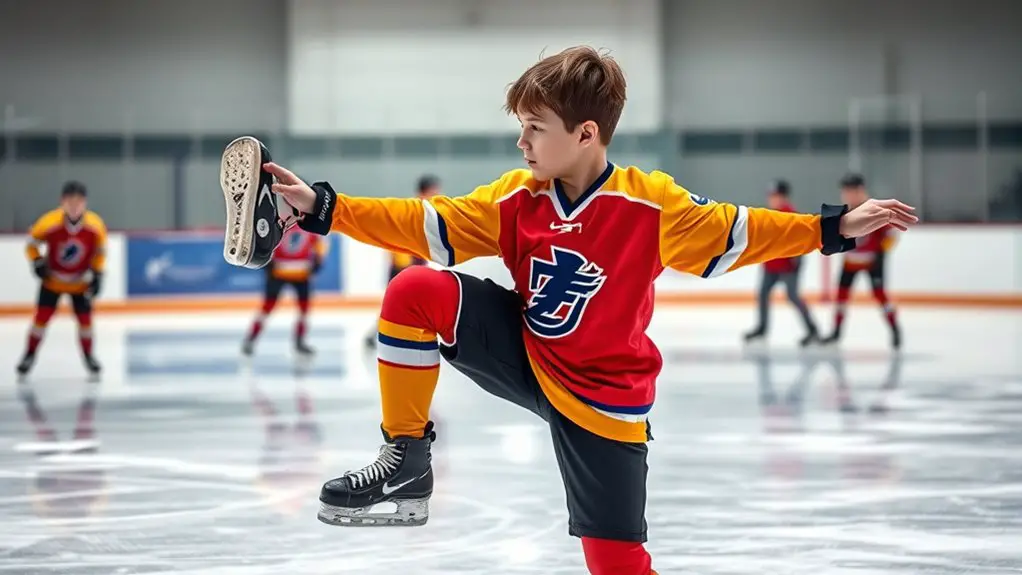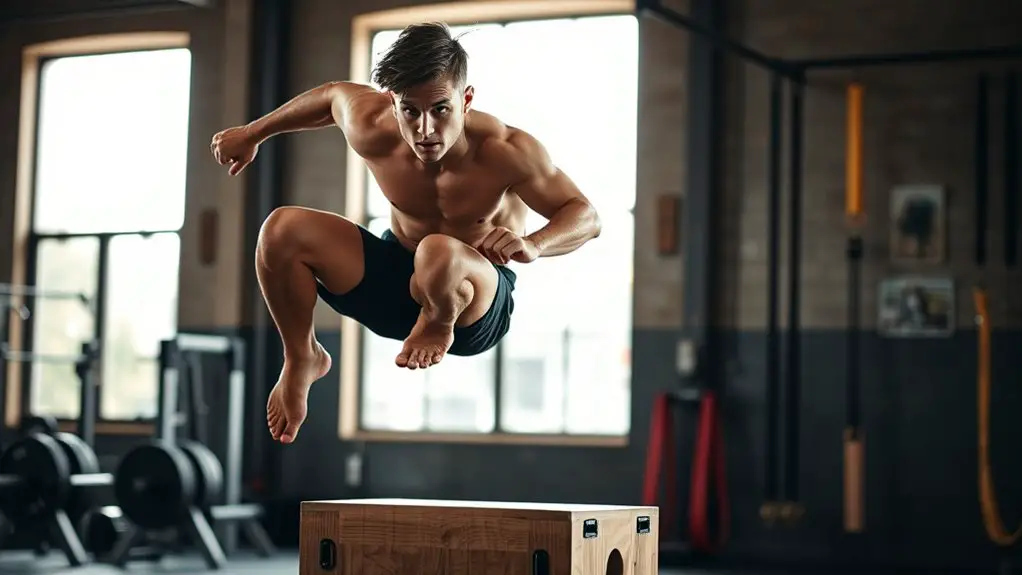Strengthening your core is essential for better balance in hockey. It enhances your agility and stability, allowing you to pivot and shoot with precision. Focus on key muscles, like your abdominals and obliques, through exercises such as planks and Russian twists. Incorporating balance training with activities like single-leg stands will further improve your equilibrium. Your nutrition also plays an important role in muscle recovery. Keep going to discover more effective strategies for boosting your core strength and performance.
Understanding the Importance of Core Strength in Hockey
Core strength is the foundation of athletic performance in hockey. When you think about your game, consider how core functionality plays an essential role in every move you make on the ice. A strong core not only stabilizes your body but also enhances your agility, balance, and overall control. This stability allows you to pivot, shoot, and skate with precision, elevating your hockey performance to new heights. Additionally, well-conditioned core muscles help prevent injuries, allowing you to maintain peak performance throughout the season.
Key Muscles Involved in Core Stability
When it comes to core stability in hockey, understanding the key muscles involved is essential. Your abdominal muscles, obliques, and lower back all play significant roles in maintaining balance and strength on the ice. Focusing on these areas can enhance your performance and prevent injuries. Additionally, engaging in exercises that strengthen stabilizer muscles can further improve your balance and stability during dynamic movements on the ice.
Abdominal Muscles Overview
A strong foundation is essential for maintaining balance and stability in hockey, and the abdominal muscles play a crucial role in this support system. Understanding the different abdominal muscle types can enhance your core muscle functions. Here's a quick overview:
- Rectus Abdominis: This muscle helps with flexing your spine and stabilizing your posture.
- Transverse Abdominis: Acting like a natural corset, it aids in core stability and pressure regulation.
- Internal Obliques: These muscles contribute to trunk rotation and lateral flexion.
- External Obliques: They assist in trunk rotation and help protect your lower back.
Obliques and Stability
While many focus on the rectus abdominis for strength, the obliques are equally essential for stability in hockey. These muscles help you maintain balance during quick turns and sudden stops. Incorporating oblique exercises into your stability training can enhance your performance on the ice.
Here's a table highlighting effective oblique exercises:
| Exercise | Description | Benefits |
|---|---|---|
| Russian Twists | Rotate your torso while seated | Improves rotational strength |
| Side Planks | Balance on one arm and side foot | Enhances lateral stability |
| Bicycle Crunches | Alternately bring knees to elbows | Engages core and obliques |
| Woodchoppers | Diagonal movement with a weight | Builds power and coordination |
| Standing Oblique Crunches | Lift knee to the side | Strengthens hip and core stability |
Engage those obliques for a more balanced game!
Lower Back Importance
The lower back plays an essential role in core stability, acting as a bridge between your upper and lower body. Strong lumbar stability isn't just about performance; it's about freedom from lower back pain. To enhance your core stability, focus on these key aspects:
- Strengthening: Target your erector spinae and multifidus muscles.
- Flexibility: Incorporate stretches that improve mobility in the lumbar region.
- Balance Training: Engage in exercises that challenge your stability, like single-leg stands.
- Posture Awareness: Maintain proper posture during training and games to minimize strain.
Essential Core Exercises for Hockey Players
To excel on the ice, you need a strong core that enhances stability and power. Focusing on essential core exercises can give you the edge you're looking for. Start with planks and their variations—try side planks to hit those obliques. Russian twists are another fantastic choice, helping you build rotational strength vital for quick movements. Incorporating leg raises can amplify your core strength benefits, teaching your body to stabilize through the lower body as well.
Don't forget about stability ball exercises; they'll challenge your balance while further engaging your core. By mixing these core exercise variations into your training routine, you can develop the strength needed to maintain control on the ice. With a solid core, you'll find it easier to skate, shoot, and maneuver, ultimately enhancing your performance. Additionally, a focus on functional strength training can further improve your overall athletic performance. So, embrace these exercises and watch your game transform!
Incorporating Balance Training Into Your Routine
To improve your balance on the ice, it's vital to incorporate specific balance drills and core stability exercises into your routine. These targeted activities not only enhance your stability but also support your overall performance. Good balance is essential for agility and control in sports, making it a key focus in your training regimen. Let's explore some effective ways to integrate these essential elements into your training.
Balance Drills Essentials
Incorporating balance training into your routine can greatly enhance your performance on the ice. To effectively tackle stability challenges, try these balance techniques:
- Single-leg Stands: Hold a single-leg position for as long as possible, switching legs to build stability.
- Balance Board: Use a balance board to engage your core and improve your equilibrium during practice.
- Dynamic Lunges: Perform lunges while incorporating upper body movements, focusing on maintaining balance throughout.
- Tightrope Walks: Walk in a straight line, placing one foot directly in front of the other to sharpen your balance.
Core Stability Exercises
Building a strong core is essential for enhancing your balance on the ice. By incorporating core exercise techniques into your routine, you'll notice significant improvement in your stability and overall performance. Focus on exercises like planks, Russian twists, and stability ball workouts. These movements not only strengthen your core but also engage your entire body, providing stability training benefits that translate directly to your hockey game. As you master these techniques, you'll gain more freedom of movement, allowing you to shift your weight efficiently and respond quickly on the ice. So, dedicate time to these exercises, and watch your balance soar, giving you the confidence to take on any challenge in the rink.
The Role of Flexibility in Core Strength
While many associate core strength primarily with stability and power, flexibility plays an essential role in optimizing these attributes. When your core is flexible, you enhance your overall performance on the ice. Here's how flexibility contributes to core strength:
- Improved Range of Motion: Flexible muscles allow for better movement, letting you twist and turn with ease.
- Enhanced Stability: A flexible core can adjust to balance challenges, reducing the risk of injury.
- Efficient Energy Use: Flexibility helps in the smooth transfer of energy, especially during dynamic movements.
- Active Recovery: Incorporating dynamic stretching into your routine aids in muscle recovery, keeping your core agile and ready. Additionally, mobility training enhances overall performance by improving range of motion and movement efficiency.
Plyometric Exercises for Enhanced Core Power
Flexibility sets the stage for effective core engagement, but to truly amplify your performance on the ice, plyometric exercises can take your core power to the next level. These explosive movements not only enhance your strength but also improve your agility and balance, key components for any hockey player. Incorporating plyometric exercises into your training routine offers incredible plyometric benefits. Think box jumps, medicine ball slams, and burpees—each of these moves challenges your core while developing the explosive power you need for quick starts and sharp turns. By focusing on improving nervous system efficiency, you can train your body to respond faster to the demands of the game.
Core Workouts for Off-Ice Training
To improve your on-ice performance, incorporating effective core workouts into your off-ice training routine is vital. These core workout variations will not only enhance your stability but also contribute to your overall game. Here are some off-ice techniques to take into account:
Incorporating core workouts into your off-ice training is essential for enhancing stability and overall performance on the ice.
- Plank Variations: Try side planks or plank jacks to challenge your core.
- Medicine Ball Throws: Engage your core while improving power and coordination.
- Russian Twists: This move strengthens your obliques, essential for quick directional changes.
- Bicycle Crunches: Target your entire core with this dynamic exercise.
Incorporating flexibility and mobility work into your training will further enhance joint function and decrease injury risk.
Tips for Maintaining Core Engagement During Gameplay
To maintain core engagement during gameplay, you need to focus on your body awareness. By staying in tune with your movements, you can better activate your core as you maneuver on the ice. Additionally, utilizing breathing techniques can help keep your core engaged, enhancing your stability and balance. Prioritizing mobility training not only supports better core activation but also reduces the risk of injuries, allowing for improved performance on the ice.
Focus on Body Awareness
How can you guarantee your core stays engaged during gameplay? Focusing on body awareness techniques and proprioceptive training is key. Here are some practical tips to help you maintain core engagement:
- Tune into Your Body: Regularly check in with your posture and alignment, ensuring you're aware of how your core feels.
- Use Visual Cues: Set markers on the ice to remind you to stay centered and engaged in your movements.
- Practice Balance Drills: Incorporate exercises like single-leg stands to enhance your stability and core activation.
- Engage Your Senses: Pay attention to your body's feedback—notice how your core responds during different maneuvers.
Utilize Breathing Techniques
Ever wonder how your breath can impact your core stability on the ice? By focusing on your breathing patterns, you can enhance your diaphragmatic engagement, which is vital for maintaining core strength during gameplay. When you breathe deeply and intentionally, you support your core muscles, allowing them to work more effectively. Try incorporating rhythmic breathing techniques while skating or shooting; this not only helps with stability but also keeps you relaxed and focused. Remember to exhale fully during exertion, which can help you maintain a strong core while maneuvering on the ice. Embrace these breathing techniques, and you'll find that a solid core leads to better balance and freedom in your game.
Nutrition's Impact on Core Strength and Performance
While many players focus on physical training to enhance their core strength, nutrition plays an important role that shouldn't be overlooked. What you fuel your body with directly impacts your performance on the ice. Here are some key nutrition tips to take into account:
- Balanced Diet: Incorporate lean proteins, healthy fats, and complex carbs to support muscle growth and energy.
- Nutritional Supplements: Think about supplements like protein powders or omega-3s to boost recovery and overall health.
- Hydration Strategies: Staying hydrated is vital. Drink water consistently and think about electrolyte drinks for intense practices.
- Pre-Game Fuel: Eat a nutrient-rich meal before games to guarantee you have the energy needed for peak performance. Additionally, ensure you are getting sufficient quality sleep, as it enhances muscle recovery and overall athletic performance.
Monitoring Progress and Adjusting Your Training Plan
As you work on strengthening your core, regularly monitoring your progress is essential for maximizing your training effectiveness. Progress tracking isn't just about hitting numbers; it's about feeling how your body changes and adapting your training plan to suit your needs. Start by setting specific, measurable goals that align with your hockey performance. Use a journal or an app to log your workouts, noting improvements in strength, stability, and balance.
If you notice plateaus or setbacks, don't hesitate to make training adjustments. This might mean varying your exercises, changing your intensity, or even incorporating rest days. Listen to your body—it'll guide you in tweaking your routine for better results.
Frequently Asked Questions
How Does Core Strength Improve My Overall Hockey Performance?
Core strength plays an essential role in your overall hockey performance. It enhances core stability, allowing you to maintain balance during fast-paced movements. When your core is strong, you're more agile, which means you can change directions quickly and effectively. This performance enhancement lets you execute plays with confidence and precision. Ultimately, a strong core gives you the freedom to play your game, minimizing the risk of injury while maximizing your potential on the ice.
Can I Strengthen My Core Without Gym Equipment?
They say where there's a will, there's a way. You can definitely strengthen your core without gym equipment! Bodyweight exercises like planks, mountain climbers, and leg raises can enhance your core stability effectively. These movements not only require minimal space but also give you the freedom to train anywhere. Just dedicate some time each day, and you'll notice a significant improvement in your core strength and overall fitness.
What Role Does Posture Play in Core Strength?
Posture plays an essential role in core strength and stability. When you maintain proper posture alignment, your core muscles engage effectively, supporting your spine and improving balance. You'll find that good posture not only enhances your core stability but also helps you move freely and confidently. By focusing on how you hold your body throughout the day, you can strengthen your core naturally, giving you the freedom to perform at your best.
How Often Should I Train My Core Each Week?
Imagine you're juggling various tasks in a day. Just like balancing those balls, your core training frequency should be consistent but varied. Aim for 2-4 times a week, mixing core workout variety to keep it engaging. You might combine planks, twists, and stability ball exercises. This approach not only strengthens your core but also adds freedom to explore different routines, ensuring you stay motivated and balanced in your fitness journey.
Are There Age-Specific Core Training Recommendations for Hockey Players?
When it comes to age-specific core training recommendations, you should definitely consider youth training and age adaptations. Younger athletes can focus on fun, engaging activities that build core strength while promoting overall fitness. For older players, more structured workouts targeting specific muscle groups can be beneficial. Remember, the goal is to create a balanced approach that matches your age and skill level, ensuring you enjoy the freedom of movement and performance on the ice.




